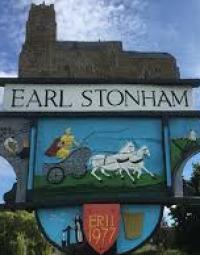

Earl Stonham
Parish Council


Parish Council
FORWARD GREEN ∼ A short history ∼ Bim Wilson wrote the following as a “long winded answer to Jen’s article about the tree guards in the last Recorder!”
In the Suffolk Record Office there is a copy of a map of 1587 of the Manor of Earl Stonham. A manor was an area of land allocated to a lord by the King in payment for services, and the map has the same boundaries as the Parish of Earl Stonham today. At the time of the Domesday Book, 1086, the Manor was owned by Roger le Bigot (I imagine he was a Norman who was rewarded by William the Conqueror after the Battle of Hastings) and was passed down the line to Roger Bigod 5th Earl of Norfolk who died in 1305, hence the Earl in our village name. The map shows four greens: Middlewood Green, Forrolde (now Forward) Green, Broad Green and Wicks Green. They are all shown as open spaces on the map, whilst the rest of the land is divided into areas with the name of the farmer written on each area.
Before the days of the Welfare State, Overseers of the Poor were appointed in each parish to look after impoverished parishioners. By the beginning of the 19th Century, Suffolk had ceased to be prosperous as farming went into a decline; it lacked the natural resources (such as coal) needed for the Industrial Revolution. There was an Act of Parliament of 1831 to help the poor. As a consequence of this Act, The Lords of the Manor of Earl Stonham and others conveyed to “the Churchwardens and overseers of the Poor Middlewood, Forrolde and Broad Greens for the benefit of the poor of the parish” on April 2nd 1832. This conveyance is lodged at the Record Office. On the same date they drew up another document (now missing) empowering the Churchwardens and overseers to enclose common lands known as Middlewood Forrolde and Broad Greens for the use of the parish and poor persons within it.
Following another Act of Parliament the Parish Council was formed in 1894. The following information comes from the Minute Book 1894 to 1944; for the most part it is written in immaculate copperplate handwriting. At the first meeting on December 13th 1894 the “Allotment Deed” was passed over to the Council; this was probably the enclosure document of 1832 of which there is a copy amongst the clerk’s correspondence. Anyway, Trustees to the Parish Allotments were appointed on January 19th 1895, and the Parish Council still administers the Allotments at Middlewood Green and Broad Green. Mr F Runneckles, Clerk and Assistant Overseer of the Poor, wrote in the minutes for February 2nd 1895 “A discussion took place with regard to Forrolde Green being put in proper order for a Recreation Ground. It was agreed that the chairman take legal advice on the subject.” Unfortunately the chairman, the Reverend Eastley, died before the end of the year and there is no record of further action. It is interesting to note that the Council met in the New School (built about 1870) in 1901, and the address is written as Forward Green rather than Forrolde Green. From then on the Green is referred to as Forward Green.
There are further entries over the years showing that the upkeep of the Green was causing problems. On April 11th 1923 the entry reads “It was decided to put a notice board on the Green to read as follows ‘Gipsies (sic) and others are forbidden to encamp on this green or place any obstruction thereon”; and another entry on December 13th 1930 “Destruction of surface by indiscriminate camping”; and on November 25th 1930 “Complaint received about drivers driving over the play and pitch at Forward Green”. And now to the point of this article: at the meeting of December 3rd 1929 the Council received a letter from the Reverend A L Gedge asking if the Earl Stonham Charity Estates could plant trees and erect seats on Forward Green. This resulted in the row of horse chestnut and lime trees being planted in 1930. It does not appear to have been to celebrate any particular occasion. Bim Wilson